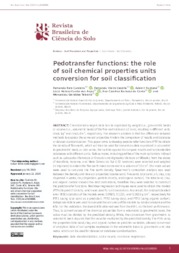Pedotransfer functions: the role of soil chemical properties units coversion for soil classification.
Pedotransfer functions: the role of soil chemical properties units coversion for soil classification.
Autoria: CORDEIRO, F. R.; CESÁRIO, F. V.; FONTANA, A.; ANJOS, L. H. C. dos; CANTO, A. C. B. do; TEIXEIRA, W. G.
Resumo: Chemical soil analysis data can be expressed by weight (i.e., gravimetric basis) or volume (i.e., volumetric basis) of the fine earth (sieved >=2 mm), resulting in different units, cmolc kg-1 and cmolc dm-3, respectively. The research problem is that the difference between methods to express the same soil properties hinders the comparison of results and database or dataset standardization. This paper aims to develop pedotransfer functions (PTF) to obtain the density of fine earth, which will then be used for conversion data expressed in volumetric to gravimetric basis, or vice versa, that will be applied to compare results and to standardize databases with different units. Soils samples, including profiles of the main soil orders in Brazil such as Latossolos (Ferralsols or Oxisols)and Argissolos (Acrisols or Ultisols), from the states of Rondônia, Roraima, and Mato Grosso do Sul (132 horizons) were selected and weighed (in triplicate) to obtain the fine earth mass contained in a volume of 10 cm3. The mass values were used to calculate the fine earth density. Spearman's correlation analysis was used between the density and nine soil properties (coarse sand, fine sand, total sand, silt, clay, clay dispersed in water, clay dispersion, particle density, and organic carbon). The total sand, clay, and organic carbon showed the best correlations, therefore they were selected to construct the pedotransfer functions. Nonlinear regression techniques were used to obtain the models (PTFs) to predict density, which was used for unit conversion. As a result, the residual standard error (RSE) statistics of the models were: 0.0920, 0.1231, and 0.1633 g cm-3, respectively for PTF1 (using total sand as a predictor), PTF2 (using clay), and PTF3 (using organic carbon). Independent data was used to evaluate the accuracy of the models by residue analysis and the RSE. For the validation, the lowest RSE obtained was from the PTF1, so the best performance. Thus, to convert values of the chemical properties from a volumetric to gravimetric basis, the value must be divided by the predicted density. While, the conversion from gravimetric to volumetric basis requires that the value be multiplied by the predicted density. The PTFs using the properties total sand, clay, and organic carbon as predictor variables, allowed conversion of analytical data of soil samples expressed in the volumetric basis to gravimetric and vice versa, which can be used for dataset or database standardization.
Ano de publicação: 2020
Tipo de publicação: Artigo de periódico
Unidade: Embrapa Solos
Observações
1 - Por padrão são exibidas publicações dos últimos 20 anos. Para encontrar publicações mais antigas, configure o filtro ano de publicação, colocando o ano a partir do qual você deseja encontrar publicações. O filtro está na coluna da esquerda na busca acima.
2 - Para ler algumas publicações da Embrapa (apenas as que estão em formato ePub), é necessário ter, no celular ou computador, um desses softwares gratuitos. Sistemas Android: Google Play Livros; IOS: iBooks; Windows e Linux: software Calibre.
Acesse outras publicações
Acesse a Base de Dados da Pesquisa Agropecuária (BDPA) para consultar o acervo completo das bibliotecas da Embrapa.

